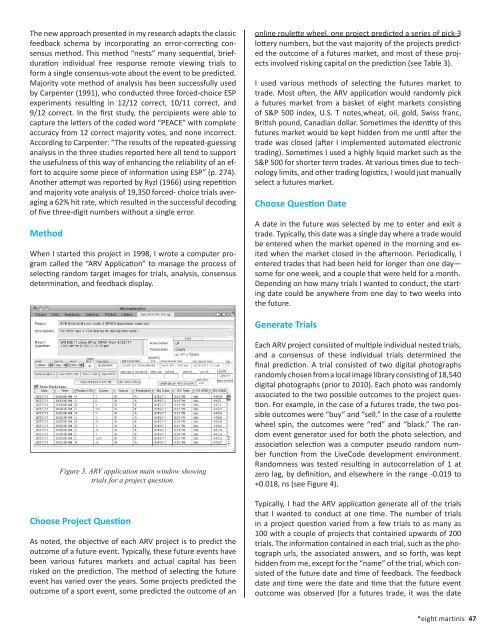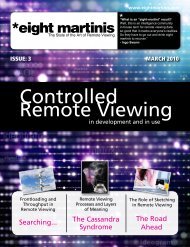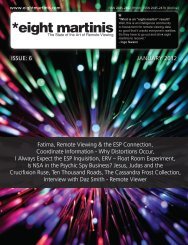Download FREE now! - Eight martinis is a magazine
Download FREE now! - Eight martinis is a magazine
Download FREE now! - Eight martinis is a magazine
You also want an ePaper? Increase the reach of your titles
YUMPU automatically turns print PDFs into web optimized ePapers that Google loves.
The new approach presented in my research adapts the classicfeedback schema by incorporating an error-correcting consensusmethod. Th<strong>is</strong> method “nests” many sequential, briefdurationindividual free response remote viewing trials toform a single consensus-vote about the event to be predicted.Majority vote method of analys<strong>is</strong> has been successfully usedby Carpenter (1991), who conducted three forced-choice ESPexperiments resulting in 12/12 correct, 10/11 correct, and9/12 correct. In the first study, the percipients were able tocapture the letters of the coded word “PEACE” with completeaccuracy from 12 correct majority votes, and none incorrect.According to Carpenter: “The results of the repeated-guessinganalys<strong>is</strong> in the three studies reported here all tend to supportthe usefulness of th<strong>is</strong> way of enhancing the reliability of an effortto acquire some piece of information using ESP” (p. 274).Another attempt was reported by Ryzl (1966) using repetitionand majority vote analys<strong>is</strong> of 19,350 forced- choice trials averaginga 62% hit rate, which resulted in the successful decodingof five three-digit numbers without a single error.MethodWhen I started th<strong>is</strong> project in 1998, I wrote a computer programcalled the “ARV Application” to manage the process ofselecting random target images for trials, analys<strong>is</strong>, consensusdetermination, and feedback d<strong>is</strong>play.online roulette wheel, one project predicted a series of pick-3lottery numbers, but the vast majority of the projects predictedthe outcome of a futures market, and most of these projectsinvolved r<strong>is</strong>king capital on the prediction (see Table 3).I used various methods of selecting the futures market totrade. Most often, the ARV application would randomly picka futures market from a basket of eight markets cons<strong>is</strong>tingof S&P 500 index, U.S. T notes,wheat, oil, gold, Sw<strong>is</strong>s franc,Brit<strong>is</strong>h pound, Canadian dollar. Sometimes the identity of th<strong>is</strong>futures market would be kept hidden from me until after thetrade was closed (after I implemented automated electronictrading). Sometimes I used a highly liquid market such as theS&P 500 for shorter term trades. At various times due to technologylimits, and other trading log<strong>is</strong>tics, I would just manuallyselect a futures market.Choose Question DateA date in the future was selected by me to enter and exit atrade. Typically, th<strong>is</strong> date was a single day where a trade wouldbe entered when the market opened in the morning and exitedwhen the market closed in the afternoon. Periodically, Ientered trades that had been held for longer than one day—some for one week, and a couple that were held for a month.Depending on how many trials I wanted to conduct, the startingdate could be anywhere from one day to two weeks intothe future.Generate TrialsFigure 3. ARV application main window showingtrials for a project question.Choose Project QuestionAs noted, the objective of each ARV project <strong>is</strong> to predict theoutcome of a future event. Typically, these future events havebeen various futures markets and actual capital has beenr<strong>is</strong>ked on the prediction. The method of selecting the futureevent has varied over the years. Some projects predicted theoutcome of a sport event, some predicted the outcome of anEach ARV project cons<strong>is</strong>ted of multiple individual nested trials,and a consensus of these individual trials determined thefinal prediction. A trial cons<strong>is</strong>ted of two digital photographsrandomly chosen from a local image library cons<strong>is</strong>ting of 18,540digital photographs (prior to 2010). Each photo was randomlyassociated to the two possible outcomes to the project question.For example, in the case of a futures trade, the two possibleoutcomes were “buy” and “sell.” In the case of a roulettewheel spin, the outcomes were “red” and “black.” The randomevent generator used for both the photo selection, andassociation selection was a computer pseudo random numberfunction from the LiveCode development environment.Randomness was tested resulting in autocorrelation of 1 atzero lag, by definition, and elsewhere in the range -0.019 to+0.018, ns (see Figure 4).Typically, I had the ARV application generate all of the trialsthat I wanted to conduct at one time. The number of trialsin a project question varied from a few trials to as many as100 with a couple of projects that contained upwards of 200trials. The information contained in each trial, such as the photographurls, the associated answers, and so forth, was kepthidden from me, except for the “name” of the trial, which cons<strong>is</strong>tedof the future date and time of feedback. The feedbackdate and time were the date and time that the future eventoutcome was observed (for a futures trade, it was the date*eight <strong>martin<strong>is</strong></strong> 47







